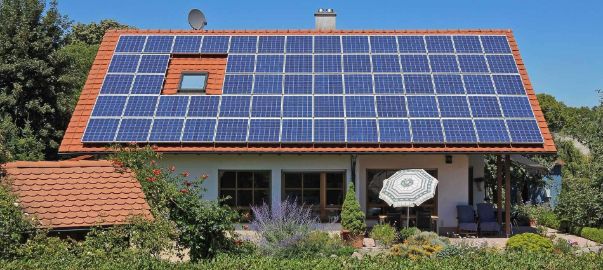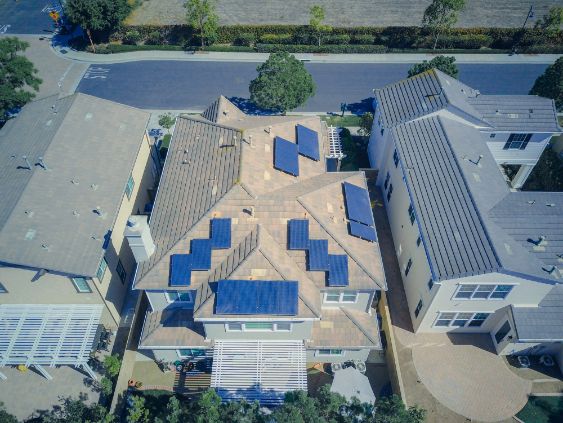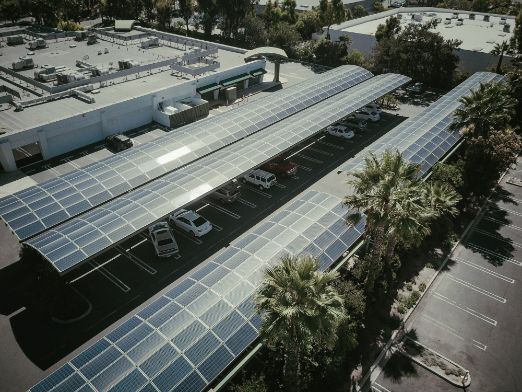A 10kW solar system’s advantages are covered in the article that follows. Most importantly, we talk about the energy output of these 10kW systems. This helps you decide if a 10kW system is appropriate for your home using this information as well.
More people are choosing to install larger solar system sizes as the cost of solar energy continues to decline. As a result, 10 kW solar systems are now a common solar option for big houses and little offices.
You might not even need that much power, but a 10kW solar system is still a sizable investment! In this article, we examine more closely to determine whether a 10kW solar system is a right size for you.
How Much Energy Does a 10kW Solar System Produce?
On average, a 10 kW system will produce about 1,255 kilowatt-hours (kWhs) of electricity per month, or between 13,400 and 16,700 kWh per year.
Your solar system will produce different amounts of energy depending on where you live, just like with price. In spite of being the same size, a 10 kW solar panel system in warm Arizona is probably going to produce more energy than a 10 kW system in Minnesota.
Despite this, solar panels are still worthwhile in less sunny states, especially because these states have a tendency to use less electricity.
Can a 10kW Solar System Power a Home?
Yes, a 10kW solar panel system will provide enough power to power an average American household for a year, which uses about 10,715 kWh of electricity.
But compared to the typical American household, your home’s energy requirements might be very different. In reality, there are big differences in energy consumption between states. In comparison to homes in other states, homes in Wyoming and Louisiana, for example, typically use more electricity.
So while a 10kW solar array might be ideal for a home in Louisiana, it might be excessive for a home in a state like New York, where the average electricity consumption is much lower.
10kW solar systems do produce enough electricity that you could go off-grid. The only drawback is that a 10kW off-grid solar system would require the installation of solar battery storage to store the extra electricity it generates.
How Much Can You Save on Your Electricity Bill With a 10 KW System?
We’ve learned from our market research that the typical U.S. homeowner will save about $1,970 on annual electricity costs per year by installing a 10 kW solar system.

The average American, however, a homeowner spends $1,410 on electricity a year, so installing a 10 kW system very well may eliminate your electricity bill.
However, if your solar panels are not producing enough electricity, such as at night, you may still receive a utility bill that includes grid infrastructure fees or any additional power you use from the grid. This will depend on your electricity provider. (This won’t apply if you install an off-grid solar system, but the majority of solar systems are connected to the grid.)
Also excluded from this savings is net metering, a system that allows you to receive credit for any extra electricity you send to the grid. You could not only completely eliminate your energy costs if you reside in a state with a true net metering system, but you could also receive credits or other payments from your utility provider.
Net metering usually works in one of two ways:
- Net metering at a retail price: Each kilowatt-hour you send to the grid is fully credited to you. If you are charged 16 cents per kWh consumed, for instance, you will receive a credit of 16 cents for every kWh exported. 29 states have laws requiring this kind of net metering.
- Net metering at a reduced feed-in tariff: A lower credit rate is applied to excess electricity that is sent to the grid. For instance, you might pay 10 cents for each kWh exported while being charged 16 cents per kWh for consumption. In 17 of the states where retail-rate net metering is not required, feed-in tariffs and other alternative programs are used.
The exact kWh retail price and solar feed-in tariff will depend on your electricity plan; keep in mind that this is just a simplified example.
How Long Does It Take for a 10kW Solar System to Pay for Itself?
Depending on where you live, the average payback period for a 10kW system can range from 8 to 20 years.
The cost of your system, the amount of electricity it produces, and the amount of money you’ll save with it all depend on where you live, which also affects the payback period. If you reside in a region that offers additional solar rebates like solar renewable energy credits (SRECs), your return on investment may be even higher.

How Many Panels Are Needed in a 10 KW Solar System?
Depending on the solar panel type you select, a 10 kW system requires between 28 and 40 photovoltaic (PV) solar panels. Remember that the typical solar panel is 65 by 39 inches, or roughly 17.5 square feet when you’re measuring your roof space or ground space for a rooftop solar panel kit or a ground-mount solar array.
Monocrystalline or “mono” solar panels are the most efficient and have the highest wattage, followed by polycrystalline, and then thin-film. The output of less-efficient solar panels can be as low as 250 W, compared to the 330 W to 360 W of the best solar modules currently available on the market.
If you want to purchase a 10 kW (10,000 W) system and you buy solar panels with an output of 340 W, you’ll need about 28 panels. This is how your equation will appear: 10,000 W / 340 W = 27.7 panels.
Even though a lower-efficiency model is less expensive than a more expensive high-efficiency one, keep in mind that you may end up paying the same or more for your solar energy system overall because you’ll need to purchase more panels.
How Much Roof Space Do You Need for a 10kW Solar System?
Typically, a 10kW solar installation needs 475 to 615 square feet of roof space. The wattage of the solar panels you install determines the precise square footage you require. More panels are required for a given wattage, which raises the requirement for roof space.
In order to maximize the amount of energy the panels will produce, you should aim to install your panels on a roof that is at least 475 square feet in size and faces south.
How to Find the Right Installer for a 10 KW System?
Even though most solar companies can install any size system, you should pick the top solar installer in your area for the job. Here are a few factors to look out for when choosing a solar company:
Solar Company Availability

Except for SunPower, even well-known solar companies generally only offer services in a maximum of 25 states. You’ll probably have lots of options if you reside in one of the best states for solar, such as California, Texas, or North Carolina. On the other hand, if you live in a region where solar renewable energy is still developing, you might only have a small number of solar installers nearby.
Solar Costs and Financing
Solar financing options vary between businesses. Find the one with the most affordable price and payment schedule for your family.
Free Home Consultations
A free home evaluation or consultation is provided by many solar companies. Others will at least provide a free estimate based on the particulars of your home. Therefore that you can compare costs, we advise getting solar quotes from at least three different businesses. Additionally, make sure to enquire about any sales, discounts, or rebates the business may be providing.
Warranties on 10kW Solar Systems
You want to make sure that investment is protected because solar panels are a significant expense. The industry standard is for top solar panels for your home to come with a warranty of at least ten years.
Conclusion
One of the best choices you can make, both for the environment and for yourself, is to switch to solar energy. Solar energy has caught up to conventional energy-generating systems and has replaced them as the main source of electricity in many American homes.
Since a solar system has so many advantages, why not opt for a 10kW system to maximize your potential? A 10kW solar system will generate between 11,000 and 15,000 kWh annually, which is sufficient to meet the annual energy needs of the typical American home, depending on where you live.
The typical 10kW solar system in the United States will cost about $21,000 after the federal solar tax credit.
